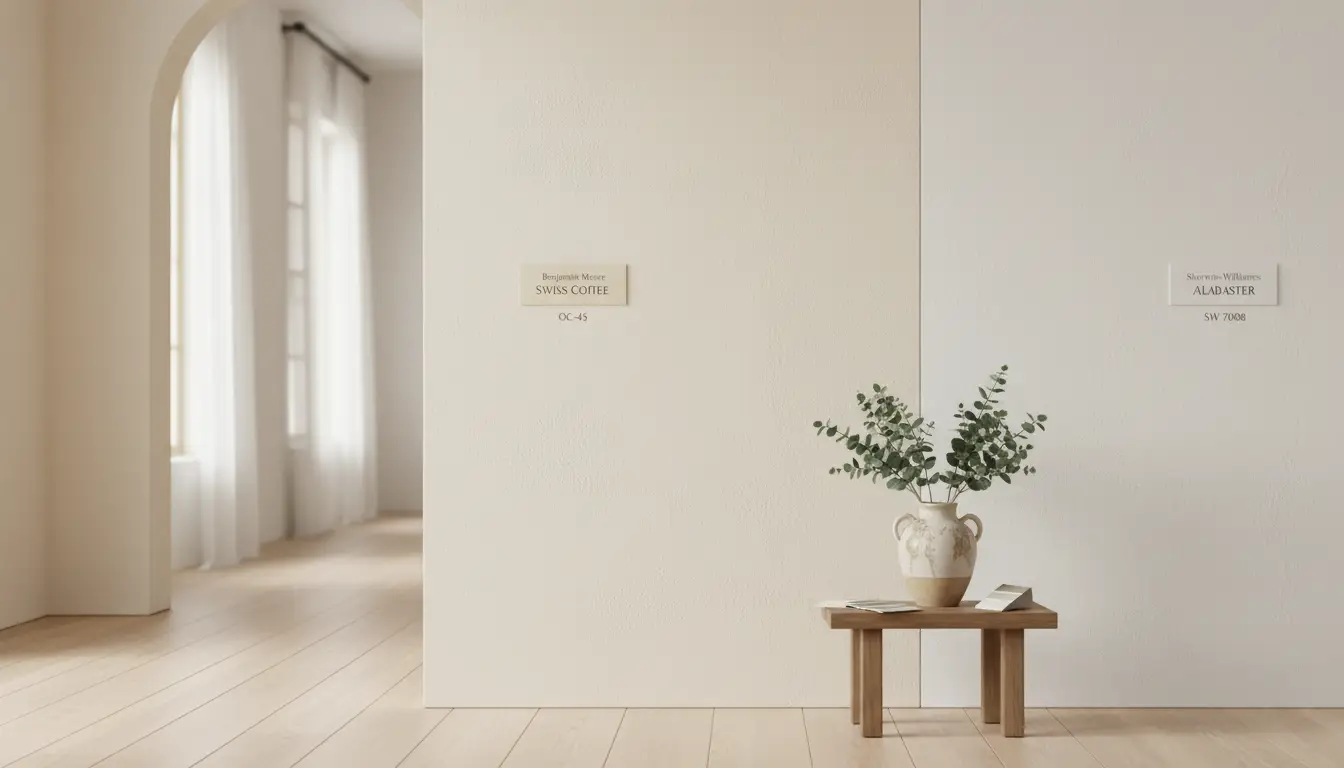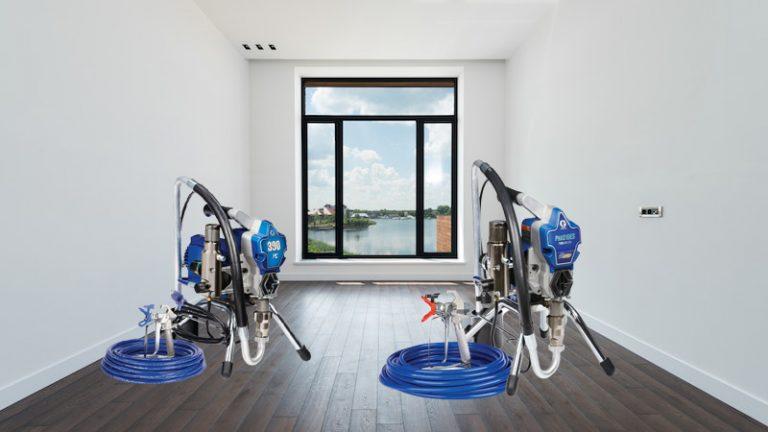BM Swiss Coffee vs SW Alabaster: Your Indispensable Guide to the Perfect White
Choosing the “perfect” white paint feels like a simple task, but it’s a decision that stumps countless homeowners. You stand in front of a wall of seemingly identical swatches, only to bring samples home and find they look completely different. This is the central struggle when comparing two of the most popular off-white paints on the market: Benjamin Moore’s Swiss Coffee and Sherwin-Williams’ Alabaster. Both promise a warm, inviting space, yet they can behave in dramatically different ways, leading to frustration and costly repainting projects. The fear of choosing a white that looks too stark, too yellow, or simply “off” is a real and valid concern that can paralyze any design project.
The problem isn’t just about picking a color; it’s about understanding the subtle science behind the paint. Factors like undertones, light reflectance value (LRV), the direction your room faces, and even the type of light bulbs you use can drastically alter a color’s appearance. Without a clear understanding of these elements, you’re essentially choosing a color blindfolded. This guide will demystify the complexities of these two beloved whites, providing a clear, actionable framework to help you select the right one for your home with confidence.
You'll Learn About
Decoding the Nuances: Swiss Coffee vs. Alabaster
At first glance, BM Swiss Coffee and SW Alabaster are incredibly similar. Both are warm off-whites that designers and homeowners adore for their versatility. However, the key to choosing between them lies in their subtle but critical differences. Understanding their unique DNA—their undertones and how they reflect light—is the first step toward making an informed decision.
The Crucial Role of Undertones
The secret language of paint is spoken in undertones. These are the subtle hints of color that emerge in different lighting conditions and are the primary reason a “white” paint can suddenly look creamy, yellow, or even slightly green. This is where Swiss Coffee and Alabaster truly diverge.
Benjamin Moore Swiss Coffee (OC-45) is a warm, creamy white that possesses a complex blend of undertones. While its dominant warmth comes from yellow, it also has subtle green and gray undertones. This complexity allows it to adapt to various settings, but the green can sometimes be a surprise. In certain lighting, especially when paired with cooler colors, this green hint can become more noticeable. This makes Swiss Coffee an excellent choice for creating a cozy, inviting atmosphere, particularly in spaces with earthy or warm-toned decor.
Sherwin-Williams Alabaster (SW 7008), on the other hand, is a softer, more neutral white. Its warmth comes from beige and greige (a mix of gray and beige) undertones. This makes it slightly less creamy and more balanced than Swiss Coffee. Alabaster’s more muted warmth allows it to function as a chameleon, pairing well with both warm and cool color palettes without strongly asserting its own color. It provides warmth without the risk of looking overtly yellow, making it a safer bet for many homeowners.
Understanding Light Reflectance Value (LRV)
Light Reflectance Value, or LRV, is a measurement of how much light a paint color reflects. The scale runs from 0 (absolute black) to 100 (pure white). A higher LRV means the color reflects more light, making a space feel brighter and more open. The LRVs of Swiss Coffee and Alabaster are nearly identical, which is why they appear to have the same brightness on a technical level.
- BM Swiss Coffee has an LRV of 81.91.
- SW Alabaster has an LRV of 82.
This marginal difference is imperceptible to the naked eye. Both colors are highly reflective and will do an excellent job of brightening up a room. The choice between them, therefore, depends less on their brightness and more on the quality of warmth you desire, which is dictated by their undertones.
Head-to-Head: A Detailed Breakdown
To make the best choice, it’s helpful to see a direct comparison of their key characteristics. This table offers a quick yet comprehensive overview to guide your decision-making process.

| Feature | Benjamin Moore Swiss Coffee (OC-45) | Sherwin-Williams Alabaster (SW 7008) |
|---|---|---|
| LRV | 81.91 | 82 |
| Primary Undertones | Yellow, with subtle green and gray hints. | Beige and greige (gray-beige). |
| Overall Feel | Creamy, cozy, and distinctly warm. | Soft, balanced, and neutrally warm. |
| Best For… | Creating inviting, comfortable spaces; pairs well with traditional and rustic decor. | Versatile applications; works with modern farmhouse, transitional, and minimalist styles. |
| Potential Pitfall | Can flash a subtle green undertone in certain lighting or next to cool colors. | Can look slightly muted or flat in a dark, north-facing room without enough artificial light. |
The Deciding Factor: How Light Transforms Color
The single most important factor in how a paint color will look in your home is lighting. Both natural and artificial light will interact with the paint’s undertones, transforming its appearance throughout the day. Understanding how your room’s specific lighting will affect Swiss Coffee and Alabaster is non-negotiable.
Natural Light and Cardinal Direction
The direction your windows face dramatically alters the quality of natural light entering the room.
- North-Facing Rooms: This light is cool and blue-toned, which can make colors appear duller or grayer. In a north-facing room, SW Alabaster is often a fantastic choice. Its inherent warmth balances the cool light without looking dingy. BM Swiss Coffee’s green undertone can sometimes be amplified by this cool light, so it’s essential to test it carefully here.
- South-Facing Rooms: These rooms are blessed with warm, bright light all day. This intense light can make warm whites appear much more yellow. Here, Alabaster’s more neutral base helps it remain a soft white without becoming overly creamy. Swiss Coffee will appear very warm and golden in a south-facing room, which can be beautiful if you’re aiming for a sun-drenched, cozy look.
- East-Facing Rooms: You’ll get bright, warm light in the morning that becomes cooler and more indirect in the afternoon. Both colors work well here, but you’ll notice a distinct shift. Swiss Coffee will be warm and inviting in the morning, while Alabaster will maintain a more consistent soft white throughout the day.
- West-Facing Rooms: The light is softer in the morning and becomes intensely warm and golden in the late afternoon and evening. This warm evening light will amplify the yellow in both colors. Swiss Coffee can become very rich and buttery, while Alabaster will glow with a soft, warm light.
The Unsung Hero: Artificial Lighting
Don’t underestimate the impact of your light bulbs. The color temperature of your bulbs can make or break your paint color choice.
- Warm White LEDs (2700K-3000K): These bulbs emit a yellowish light that enhances the warmth of both Swiss Coffee and Alabaster, making them feel cozier.
- Cool White/Daylight LEDs (3500K-5000K): These bulbs have a bluer tone that can neutralize warmth. This can be helpful if you find Swiss Coffee is looking too yellow, but it can also wash out Alabaster or bring out Swiss Coffee’s green undertone.
The Ultimate Solution: How to Choose with No Regrets
Reading about paint is one thing, but the only way to truly know how a color will look in your space is to test it. This is the most critical step in the entire process. Do not skip it.
The Right Way to Sample Paint
Never paint a small swatch directly onto your existing wall color. The old color will influence how you perceive the new one. Instead, follow this foolproof method:
- Buy Sample Pots: Get a sample pot of both BM Swiss Coffee and SW Alabaster.
- Use Large Poster Boards: Paint two coats onto two separate large, white poster boards or Samplize peel-and-stick swatches. This gives you a large, true representation of the color.
- Move Them Around: Place the painted boards on different walls within the room you plan to paint. Observe them in the morning, afternoon, and evening, with both natural light and your artificial lights on.
- Check Against Key Elements: Hold the samples up next to your trim, flooring, kitchen cabinets, and large furniture pieces to see how the undertones interact. This step is crucial for ensuring a cohesive look. When considering foundational elements of your home, it’s important to have a solid base; for major structural concerns, you might even wonder who to hire to replace sill plate, as these core components are vital to your home’s integrity.
Beyond the Walls: Coordinating with Your Home
Your wall color is just one piece of the puzzle. How it coordinates with your trim, cabinetry, and overall color palette is what creates a truly harmonious design.
Pairing with Trim Colors
Because both Swiss Coffee and Alabaster are off-whites, pairing them with a crisper, cleaner white for the trim creates a beautiful, subtle contrast that makes the wall color pop. For Alabaster walls, a great choice is Sherwin-Williams Pure White (SW 7005). For Swiss Coffee walls, Benjamin Moore Chantilly Lace (OC-65) provides a clean contrast without being too stark.
Complementary Color Palettes
Both colors are incredibly versatile and pair beautifully with a wide range of hues.
For Swiss Coffee: Its earthy warmth makes it a perfect partner for deep greens like Benjamin Moore’s Raintree Green, rich browns like Dragon’s Breath, and warm grays. It also pairs beautifully with natural wood tones and brass finishes.
For Alabaster: Its neutral warmth allows it to bridge the gap between warm and cool. It looks stunning with earthy tones like SW Urbane Bronze, soft blues and greens like SW Sea Salt, and sophisticated grays like SW Repose Gray. This flexibility is part of what makes it a designer favorite. Maintaining your home’s exterior features is also important; for instance, understanding how to daylight a drain pipe can be a crucial part of landscape and water management planning.
Final Verdict: Which White Is Right for You?
The choice between Benjamin Moore Swiss Coffee and Sherwin-Williams Alabaster comes down to the specific feeling you want to create in your home and the unique lighting conditions you’re working with.
Choose BM Swiss Coffee if:
- You want a distinctly warm, creamy, and cozy atmosphere.
- Your home has a traditional, rustic, or modern farmhouse style with lots of natural wood and earthy textures.
- You have tested it in your space and do not see the subtle green undertone, or you like the complexity it adds.
Choose SW Alabaster if:
- You want a softer, more balanced white that provides warmth without a strong yellow commitment.
- You need a versatile white that can work with a wide range of styles and both warm and cool color palettes.
- Your room has tricky lighting, as its neutral base makes it a more predictable and “safer” option. When dealing with older home renovations, sometimes you might encounter unique challenges, like figuring out if you can you plaster over ceiling tiles, which requires careful consideration of materials and techniques.
Ultimately, both are beautiful, timeless colors that can elevate any space. By understanding their subtle differences and, most importantly, testing them in your own home, you can move past the overwhelming wall of white swatches and choose your perfect color with absolute confidence.


